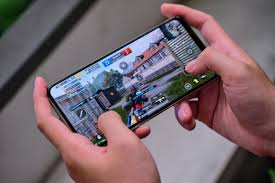The Origins of Mobile Games

Snake on its phones in 1997 is often regarded as the beginning of mobile gaming. This simple game, featuring a snake that grows in length as it consumes dots, became an instant classic, pre-installed on millions of Nokia phones worldwide. Snake’s popularity proved that there was a demand for entertainment on mobile devices, and this concept grew as mobile technology advanced.
In the early 2000s, more complex games were developed, including Tetris, Solitaire, and Sudoku. These games featured slightly better graphics and interactivity, although they still operated on monochrome or limited-color screens. At this stage, mobile games were restricted by limited processing power and minimal graphics capability, but this era laid the groundwork for what was to come.
The Rise of Smartphone Gaming
The release of the iPhone in 2007 marked a turning point in the mobile gaming industry. With a multi-touch screen, powerful processor, and internet connectivity, the iPhone set the stage for more sophisticated games. When Apple launched the App Store in 2008, developers gained an accessible platform to publish games, making it easier for players to download and enjoy a variety of titles. Other smartphone manufacturers, such as Samsung and Google’s Android, quickly followed suit, creating similar ecosystems.
One of the first games to become a global hit on smartphones was Angry Birds by Rovio in 2009. This game, featuring a cast of colorful birds launched at structures to defeat pigs, showcased the potential of touch-screen controls and the addictive nature of casual games. Its success demonstrated that mobile games could be fun, interactive, and capable of captivating a vast audience.
Key Genres in Mobile Gaming
- Casual Games
Casual games are designed to be easy to pick up and play, with minimal learning curves and quick gameplay sessions. Examples include Candy Crush Saga and Subway Surfers. These games are often free-to-play with in-app purchases and rely on vibrant visuals and simple mechanics to appeal to a broad audience. - Puzzle and Logic Games
Puzzle games are incredibly popular on mobile devices because they are intellectually stimulating and often require minimal hardware capabilities. Games like Candy Crush, Sudoku, and 2048 have amassed millions of players worldwide. - Role-Playing Games (RPGs)
RPGs allow players to immerse themselves in virtual worlds, taking on characters with unique abilities and stories. Popular RPG titles like Genshin Impact and Raid: Shadow Legends offer console-quality graphics and vast open worlds, showcasing the power of mobile devices. - Battle Royale and Shooter Games
Games like PUBG Mobile and Call of Duty: Mobile have gained immense popularity by offering multiplayer shooter experiences. These games push mobile graphics to the limits, providing an adrenaline-pumping gaming experience. - Simulation Games
Simulation games include titles like The Sims Mobile and FarmVille, which simulate real-life activities. They appeal to players interested in managing virtual worlds or life situations. - Strategy Games
Strategy games, like Clash of Clans and Rise of Kingdoms, involve planning and tactical decision-making. They often include base-building, resource management, and multiplayer competitions. - Sports and Racing Games
Games like Asphalt 9 and FIFA Mobile simulate racing or sports experiences, leveraging mobile devices’ gyroscopic and touch capabilities for immersive controls.
The Free-to-Play Model and Microtransactions
One of the defining features of mobile gaming is the freemium model, which allows users to download and play games for free, with the option to purchase in-game items, boosts, or premium content. Games like Clash of Clans and Pokémon GO popularized this model, showing that developers could make significant revenue through microtransactions rather than charging an upfront fee.
The freemium model has its pros and cons. On the positive side, it enables users to try games without committing financially, democratizing access to mobile games. On the downside, it has led to concerns about “pay-to-win” mechanics and gambling-like features that encourage spending.
Technological Advancements in Mobile Gaming
The evolution of mobile gaming has been driven by advances in hardware and software, including:
- Improved Graphics: The development of mobile GPUs (graphics processing units) has enabled the creation of high-resolution graphics, giving rise to visually stunning games like PUBG Mobile and Call of Duty: Mobile.
- Cloud Gaming: Cloud gaming services, such as Google Stadia and Xbox Cloud Gaming, allow players to stream console-quality games on their mobile devices without needing high-end hardware.
- Augmented Reality (AR): The success of Pokémon GO in 2016 showcased the potential of AR, which overlays digital elements in the real world, opening up new gameplay possibilities for mobile games.
- 5G Connectivity: The rollout of 5G networks has enhanced the mobile gaming experience by reducing latency and increasing download speeds, especially for real-time multiplayer games.
Popular Mobile Games and Their Impact
- Pokémon GO
Leveraging AR, Pokémon GO encouraged players to explore their surroundings to capture virtual Pokémon. The game not only created a cultural phenomenon but also demonstrated the potential of AR in gaming. - Candy Crush Saga
Candy Crush popularized the match-three puzzle genre and established the monetization model of in-app purchases. Its simple yet addictive gameplay helped it appeal to a wide demographic, from children to adults. - Clash of Clans
Clash of Clans became a pioneer of mobile strategy games, combining base-building, resource management, and competitive multiplayer elements. It also established the idea of “freemium” monetization with its in-game currency system. - PUBG Mobile
PUBG Mobile brought the popular battle royale genre to mobile, offering a high-quality shooter experience that was previously limited to PCs and consoles. - Genshin Impact
Genshin Impact set a new standard for mobile RPGs with its open-world gameplay, intricate storytelling, and console-quality graphics. Its success showed that mobile devices could handle complex games traditionally reserved for consoles.
The Social and Psychological Impact of Mobile Gaming
Mobile games have introduced both positive and negative effects on individuals and society. Some of the positive effects include:
- Stress Relief: Casual games like Angry Birds and Fruit Ninja provide short bursts of entertainment, helping people unwind during breaks.
- Community Building: Multiplayer games and social media features in games create communities, allowing people to connect with friends and even strangers worldwide.
- Cognitive Development: Puzzle games can help improve problem-solving skills and cognitive function.
However, there are also concerns:
- Addiction and Screen Time: Games with reward systems, such as daily quests and microtransactions, encourage excessive screen time and potentially addictive behaviors.
- Mental Health Concerns: Some mobile games incorporate mechanics similar to gambling, with “loot boxes” that offer random rewards. This has led to concerns about compulsive spending and addiction.
The Future of Mobile Gaming
The future of mobile gaming looks promising, with several trends likely to shape the industry:
- Improved AR and VR Experiences
As mobile AR becomes more sophisticated, we can expect new and more immersive games that interact with the real world. - Expansion of Cloud Gaming
Cloud gaming services will make high-quality games more accessible on mobile devices, reducing dependency on hardware. - Greater Cross-Platform Integration
More games are enabling cross-platform play, allowing mobile players to connect with console and PC gamers in multiplayer games, broadening the scope and appeal of mobile games. - Esports and Competitive Gaming
Mobile esports is growing, with games like PUBG Mobile and Call of Duty Mobile hosting competitive tournaments. This trend is likely to continue, making mobile games an integral part of the global esports scene. - Focus on Inclusivity and Accessibility
Game developers are increasingly focusing on making games accessible to a diverse audience, including individuals with disabilities, ensuring that everyone can enjoy mobile gaming.
Conclusion
Mobile games have come a long way from the simple days of Snake and Tetris. With improvements in technology, a diverse range of genres, and a massive global player base, mobile gaming has become one of the most popular and lucrative forms of entertainment. As mobile devices continue to evolve, we can expect even more innovative games that push the boundaries of what is possible on a smartphone or tablet.





